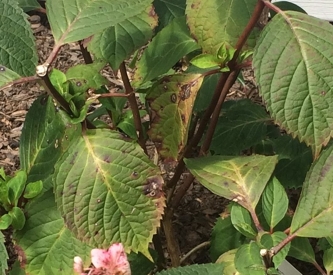The Basic Principles Of Hydrangea Leaves Turning Yellow
Table of ContentsThe Single Strategy To Use For Hydrangea Leaves Turning Yellow4 Easy Facts About Hydrangea Leaves Turning Yellow DescribedHydrangea Leaves Turning Yellow Fundamentals ExplainedHow Hydrangea Leaves Turning Yellow can Save You Time, Stress, and Money.
One possibility is that the plant is not obtaining sufficient sunlight. Throughout the cold weather, the days are shorter, and the sunlight is not as intense, so make certain to put your Hydrangea in a spot where it will certainly access the very least 6 hours of sunlight each day. Another factor for Hydrangea yellow leaves in winter might be way too much water.The fallen leaves could be transforming yellow due to temperature level stress (Hydrangea Leaves Turning Yellow). Hydrangeas like cooler temperatures, so if the plant remains in a spot that obtains as well warm or as well cold, the leaves will certainly transform yellow. If you assume temperature stress could be the concern, try moving your Hydrangea to a various location or safeguarding it from the components with a cloth wrap
New development will certainly be observed in very early spring, when you'll notice eco-friendly foliage sprouting from stems that may have appeared dead. If your leaves are turning brown in spring or summer, there are most likely various other variables at play. The specific reasons depend on the variety and their expanding problems, yet generally, brownish hydrangea fallen leaves suggest dehydration and wilting in the warm.
In the spring when the mercury remains reasonably reduced, they'll do fine. When things heat up over the summer however, time spent in the early mid-day rays can create unimaginable damage.: Expand your hydrangeas in a place where they'll get sunlight in the early mornings or nights, but not throughout the peak hours.
Things about Hydrangea Leaves Turning Yellow
Wilting is brought on by lack of wetness, suggesting there are a few great tricks to use to avoid this from happening. Provide your hydrangeas a healthy glug of water every few days when the temperatures are climbing up high, and deal with the soil to far better preserve dampness. Hydrangea Leaves Turning Yellow. After sprinkling, a dab of compost around the base of each plant ought to assist with this by maintaining wetness in the soil
This interrupts fungis spores from settling. "The Botrytis fungus flourishes in trendy and damp problems, so prevent bathing the entire plant when watering and just water at the origins," shares Roy Nicol, a Master Gardener. If you have actually missed the opportunity for prevention and are taking care of an infection you should eliminate all dead or drastically contaminated fallen leaves from the plant and destroy them to protect against additional spread.
As a general general rule, we recommend removing fallen leaves when they are 50% brownish or greater. While browning triggered by any type of factor can't be turned around, taking the restorative activity described above will motivate the plant to expand brand-new leaves so the damaged leaves either diminish naturally or can be removed by the gardener.
Hydrangeas need to be watered just when the top few inches of dirt are completely dry, and need to be provided a detailed soaking each time. Underwatered hydrangeas are likely to have yellow, wilting, and sagging fallen leaves.
The 20-Second Trick For Hydrangea Leaves Turning Yellow
The method you repair hydrangea leaves turning yellow relies on the key issue creating the yellow leaves. This can be difficult to figure out, once you do you will certainly be able to adjust your plant care appropriately to care for the problem. As stated previously, a typical problem with hydrangeas is vitamins and mineral deficiencies.

Additionally, you can acquire and mount simple watering globes. Watering worlds hold water in them and gradually launch this water right into the dirt as the ground comes to be dry. Simply load the world with water, stick the spout into the soil within the root zone near the base of the plant, and leave it in area till all the water is gone.

The Best Strategy To Use For Hydrangea Leaves Turning Yellow
To prevent spreading fungal conditions, make sure to thouroughly tidy and decontaminate any trimming devices prior to and after usage (Hydrangea Leaves Turning Yellow). Ultimately, you can try to flush the roots with water to eliminate excess fertlizer.
Your hydrangea plant favors well-drained, moist dirt. If the pot has poor drainage, or your dirt is flooded, the fallen leaves will begin to transform yellow. Overwatering makes the soil soggy. Flooded and soggy dirt can cause stunted growth, leaf discoloration, and, worst of all, rot fungal additional reading diseases. Even though over-watering can be damaging, under-watering is not an option either.
If you don't water your hydrangea plant for more than a week, the leaves will begin transforming yellow. Fungal diseases that strike the plants you could try these out tend to reveal indications on the roots and the leaves of the plant.
Leaf spot is an additional fungal condition that can target hydrangea. It results in the fallen leaves turning yellow and the look of brownish and purple areas on the leaves.